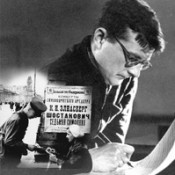
The Seventh (Leningrad) Symphony of D. D. Shostakovich was performed in besieged Leningrad
August 9, 1942 in the Hall of the Leningrad Philharmonic was performed the Seventh Symphony of Dmitri Shostakovich.
In the first weeks of the Great Patriotic War, which found Shostakovich in his native city, Leningrad, he began to write the Seventh Symphony, which became one of his most important works. The composer worked with the utmost diligence and creativity, although he could write it only in snatches. Together with other Leningraders, Dmitry participated in the defense of the city: he worked on the construction of antitank fortifications, was a fighter of a fire-prevention team, was on duty at night in attics and on roofs of houses, put out incendiary bombs. By mid-September Shostakovich completed two parts of the symphony, and September 29 completed the third part.
In mid-October 1941 from the blockaded city he and his two young children were evacuated to Kuibyshev, where he continued to work on the symphony. In December, the final part was written, and preparations for production began. The premiere of the Seventh Symphony was held March 5, 1942 in Kuibyshev, at the Theater of Opera and Ballet, performed by the Bolshoi Theatre Orchestra conducted by S. A. Samosud. March 29, 1942 the symphony was performed in Moscow.
Initiator and organizer of the performance of the Seventh Symphony in besieged Leningrad was chief conductor of the Bolshoi Symphony Orchestra of the Leningrad Radio Committee, K. I. Eliasberg. In July, by a special plane, the score was delivered to Leningrad. Rehearsals began. To perform the symphony a reinforced orchestra was needed. Therefore, a great work was done to search for surviving musicians in Leningrad itself and at the nearest frontline.
9 August 1942, at a packed hall of the Leningrad Philharmonic, took place the performance of the Seventh Symphony. 80 minutes while the music was playing, enemy guns were silent: the gunners defending the city were ordered by the commander of the Leningrad Front, L. A. Govorov to suppress the fire of the German guns by all means. Operation of fire suppression of enemy batteries was called "Flurry". The performance of the symphony was broadcasted on radio and over the city network of loudspeakers. It was heard not only by citizens, but also by German troops besieging Leningrad. New work by Shostakovich shocked listeners, inspired confidence, and strengthened the city's defenders.
Later, the Symphony was recorded by many distinguished conductors, both in the USSR and abroad. The music of the 1st part of the symphony was used to accompany the "Leningrad Symphony" ballet, which became widely well-known.
The Seventh ("Leningrad") Symphony of Shostakovich is, by right, not only one of the most important literary works of Russian culture of the 20th century, but the musical symbol of the siege of Leningrad.
Lit.: Акопян Л. О. Дмитрий Шостакович. Опыт феноменологии творчества. СПб, 2004; Линд Е. А. «Седьмая...». СПб., 2005; Лукьянова Н. В. Дмитрий Дмитриевич Шостакович. М., 1980; Петров В. О. Творчество Шостаковича на фоне исторических реалий XX века. Астрахань, 2007; Хентова С. М. Шостакович в Петрограде-Ленинграде. Л., 1979.
Based on the Presidential Library’s materials:
Defence and Siege of Leningrad: [digital collection];
Симфония № 7 [Ноты]: для оркестра: op. 60 / Дм. Шостакович. [Тетрадь III]: Adagio. [Куйбышев, 1942];
Симфония № 7 (Ленинградская). Часть 1. Allegretto: [аудиозапись]. [15 июля - 8 сентября 1941 г.];

